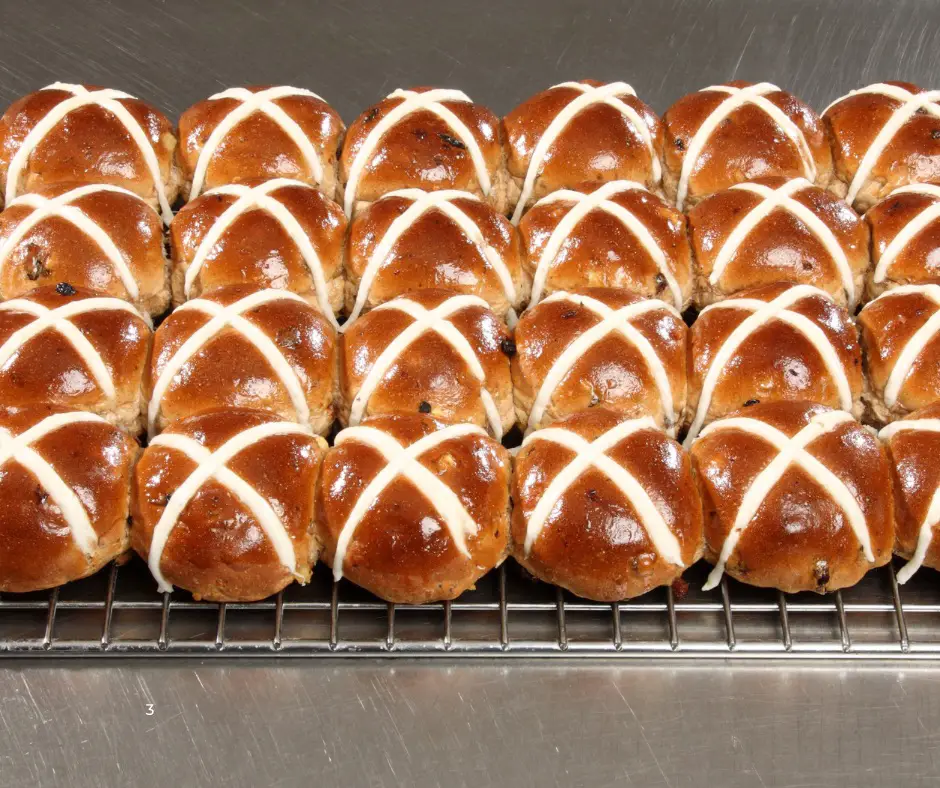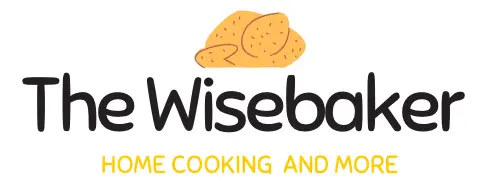As the season approaches, one traditional treat that’s a must-have in many households is the hot cross bun.
This humble yet glorious pastry is lovingly crafted from a sweet dough that boasts an intoxicating mix of spices and dried fruit.
Perhaps the most recognizable aspect of these Easter treats is the intricate white cross piped on top.
But just what is this mysterious white mark made from?
In this article, we delve deeper into the rich history of the hot cross bun and uncover fascinating facts about its iconic white cross.
Furthermore, we will discern the three distinct types of white crosses found atop hot cross buns and investigate why variations exist.

What Is The Stuff On Top Of Hot Cross Buns?
Hot cross buns are famed for their unique embellishment – a distinct white line forming a cross, but what exactly is this thing (if you like)?
Typically, it is a sweet and creamy icing or frosting.
This delicious touch of sweetness is prepared using powdered sugar and milk or cream, sometimes even enhanced with an infusion of vanilla or orange flavor.
The application of this frosting isn’t random by any means.
Once these puffy delights have had their time in the oven and are adequately cooled, the icing makes its grand appearance.
Piped or drizzled meticulously in a linear motion across the bun, adorning it with that characteristic cross symbol.
Far from being just decorative, this pattern holds religious significance, symbolizing Jesus’ crucifixion in the Christian Faith.
While today’s hot cross buns favor icing for its sugary appeal, some traditional recipes opt for a more austere approach.
They employ a paste made from humble flour and water to etch the cross before baking.
This results in a starker design without adding extra sweetness.
Delving even deeper into tradition reveals another method used to fashion the iconic ‘cross’ on top of the bun – shortcrust pastry!
Yes, you heard that right!
Renowned for its perfect balance of flour to fat (a 2:1 ratio by weight), shortcrust pastry provides a more refined texture than icing.
This style demands precision as strips of pastry are interlaced across each bun prior to baking.
How Do They Make The White Cross On Hot Cross Buns?
There are two commonly used methods: through a flour paste or icing.
Creating the Cross with Flour Paste
A classic method for creating the cross is by applying a flour paste.
This mix of plain flour and water is piped or spooned onto the buns before baking, forming a crisp cross that contrasts beautifully with the soft, sweet dough of the bun.
Some cooks might add sugar, butter or oil to give the paste extra flavor and texture.
Need some guidance?
Here’s a straightforward recipe:
Prepare 4 tbsp of plain flour and enough water to attain a thick consistency when mixed together.
Once combined properly, fill a piping bag with this mixture and pipe out a neat cross over your uncooked buns before they hit the oven.
The Icing Method
On the other hand, if you prefer a softer and sweeter cross on your hot cross buns, piping or drizzling icing onto baked and cooled buns is your choice method.
This mix of powdered sugar and liquid forms an enticingly sweet coating that complements the bun’s flavors beautifully — plus it adds a beautiful gloss!
For extra taste dimensions, you could add flavors like vanilla, orange or lemon to your icing.
Here’s an easy icing recipe:
Blend 1 ⅓ cup of icing sugar with about 2 oz of Whole Milk until smooth.
Pour this mixture into your piping bag and chill it briefly before crafting those crosses on your baked buns.
Why Are Hot Cross Buns Called Hot?
At first glance, understanding the nomenclature of hot cross buns can be quite puzzling.
The ‘cross’ part is pretty self-explanatory, given the characteristic crucifix design on the top of each bun.
But why are they termed ‘hot’?
Are they always served hot?
Is it a reference to some obscure cooking technique?
The truth lies somewhere between history, folk culture and tradition, and it’s certainly as intriguing as these sweet, spiced buns themselves.
Perhaps the most reliable explanation for this intriguing moniker traces its roots back to the bygone era of street vendors.
Picture a time when sellers hawked their goods on bustling streets with catchy cries, one among them being “Hot cross buns, hot cross buns, one a penny, two a penny, hot cross buns.”
This charming chant wasn’t just a means to attract potential customers—it soon became an indelible part of English nursery rhymes that children around the world know and love today.
Over time, this call morphed into the name itself: hot cross buns emerged from it.
This street vendor theory doesn’t conclusively explain whether these buns were indeed served hot at all times.
However, it gives substantial credence to why we still refer to them as such today.
Another possible interpretation brings us closer to home—or should we say hearth?
Hot cross buns have long been associated with Good Friday tradition.
After observing penance and fasting during Lent—characterized by modest meals and abstinence from certain foods—Good Friday marked a day when followers could finally indulge in something special.
That coveted treat was often cross buns enjoyed warm straight out of the oven or lightly toasted over an open flame.
Many adherents have kept this tradition alive even today by choosing to heat their hot cross buns before slathering them with butter for that extra bit of indulgence.

